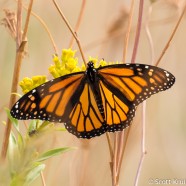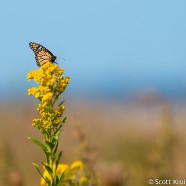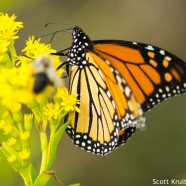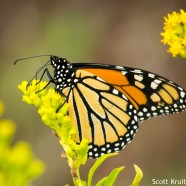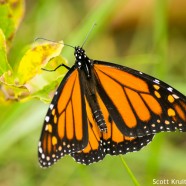Big Monarch
I am in the enviable position of staring at around ten or twenty different Monarch butterflies each day, at least. I have a good running impression of them by now, so when I see a unique individual it strikes me instantly. This female Monarch seemed to be very large, though the scale does not show that well in these photos. I watched her feeding, moving about the goldenrod, and flying around a bit, all with the same larger than typical feeling. Scott Kruitbosch Conservation & Outreach Coordinator
Read MoreMonarch Monday
Happy Monarch Monday! If you have any goldenrod growing near you now is the time to check it out as the butterflies are pouring to the south. They have to get a move on now as we near October and the air grows chillier.
Read MoreMonarchs massing in migration
This past weekend I visited a prime spot for Monarch butterfly migration: the coastal grasslands of Stratford Point in Stratford, Connecticut. Even four or six years ago one could expect to find hundreds of Monarchs at the site during the peak migratory period. The last couple of years have seen a dramatic collapse in their numbers in many parts of North America. As one of the most visible and widely known environmental disasters of the 21st century the plight of the species has been a subject of discussion for the masses. Thankfully I was able to see a decent mass of Monarchs at this...
Read MoreMonarch on goldenrod
This Monarch was feeding on goldenrod right on the edge of the coastal bluff, being whipped back and forth by the steady breeze and occasionally strong gusts of wind. It is impressive to see how well they can hang on, keeping a low profile and closed wings to prevent being literally blown away. Those beautiful black and orange sails are useful but could be potentially dangerous if not managed correctly!
Read MoreMigrant Monarch
Today I was thrilled to see several dozen Monarch butterflies as I surveyed a classic fall migration spot on the Connecticut coast. While this total may far under historic sums seen there it is still better than the last couple of years. This male, sexed by the black patches on the hind wings, was one of the more cooperatives individuals. I’ll share more photos of them all week. What are your Monarch counts looking like? Scott Kruitbosch Conservation & Outreach Coordinator
Read More



